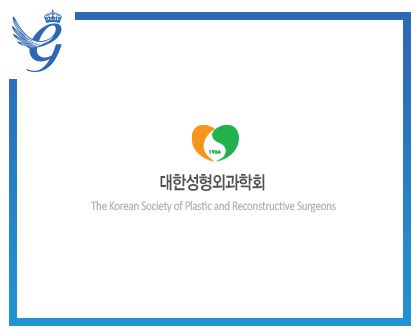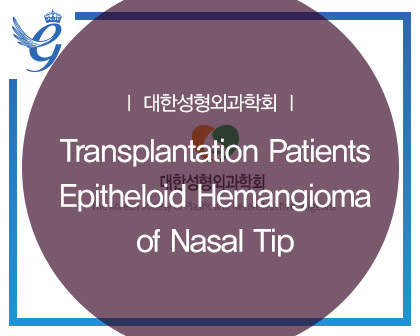<제 52차 대한성형외과 추계학술대회>
페이지 정보
작성자 그레이스성형외과 작성일15-08-10 15:58 조회1,420회 댓글4건본문

Study for Histopathologic Findings of the Hepatic Artery in the Living Related Liver Transplantation Patients Epitheloid Hemangioma of Nasal Tip
Choi MS, Lee PK, Park JG, Rhie JW, Ahn ST, Jung ES
Living related liver transplantation(LRLT) is theoretically the best treatment option for end stage liver disease and nonresectable hepatocellular carcinomas. Anastomosed hepatic artery is at high risk in thrombosis after LRLT, which directly related to the patient's life. Usually, recipient hepatic artery is so friable and intimal separation and blood clot between intima and media were noted frequently. From December 2001 to June 2003, consecutive 30 hepatic arteries were harvested from 45 LRLTs patients with end stage liver disease. All hepatic artery were anastomosed with #9-0 nylon by plastic surgeon. All hepatic arteries were patent intraoperatively and postoperatively. In the histopathologic study of hepatic artery, some had intimal thickening, myxoid change and intimal hyperplasia in 14 out of 30 cases. Since pathologic changes may develop as a result of transarterial chemoembolization(TACE) and others causes, we postulated that the prevalence of hepatic arterial thrombosis, a catastrophic graft-threatening complication of LRLT, might be increased in this subset of LRLT patients who received TACE. But, in our study, patients who underwent hepatic arterial chemoembolization statistically do not show an increased risk of developing hepatic arterial thrombosis or other hepatic arterial complications after LRLT. And pathologic changes are statistically not correlate with the TACE.
댓글목록
Melva님의 댓글
Melva 작성일
https://www.besolife.com/@georginashirk7
https://unillel-paraversum.de/montebeers9083/monte2009/wiki/Link+to+Download+on+iOS+and+Android+Devices
https://sounddeep.blacktube.in/gldnumbers8950
https://git.nusaerp.com/adam797485758/9089blackcoin.co/wiki/Top-Online-Casinos-in-Australia-2025-AUS-Real-Money-Sites
https://gitea.dusays.com/mahaliaijw8508
https://csmsound.exagopartners.com/sabineperrier4
https://pilowtalks.com/@albertinagarre
https://git.baltimare.org/abbeyosullivan
https://www.k0ki-dev.de/willartm01013
http://111.230.114.47:3000/lienpotts55653/9754blackcoin/wiki/The-Star-Gold-Coast-Casino-Guide-2025-Games-%26-Promotions
https://deaddeaddead.store/lorikramer7684
https://rightmeet.co.ke/@clairfirkins0
https://gitlab.grupolambda.info.bo/budtaft420468/6867blackcoin/-/issues/1
https://berry.work/read-blog/4267_best-online-casinos-2025.html
https://git.getmind.cn/marty66o85571
https://git.wisder.net/gabriellahunt6/4157874/wiki/Best-Real-Money-Online-Casinos-in-the-US-2025
http://kpro.shanghaiopen.org.cn:8005/carla487308016/carla1982/wiki/SGR-ASX%3A-Bruce-Mathieson-tabled-%24550m-bid-for-Star-Gold-Coast-and-was-rejected
https://meetme.goo.ng/@apagloria30864
https://vcs.int.feuerwehr-ziemetshausen.de/hollis44903449
https://talkkro.com/read-blog/7040_online-pokies-mobile-play-amp-fast-au-withdrawals.html
https://git.2ops.fun/edencordero73/blackcoin.co2009/wiki/The+Best+Online+Casinos+in+Australia+2025%253A+Top-Rated+Sites+for+Aussie+Players https://git.mklpiening.de/nellymatthaei/8915blackcoin/wiki/The-Star-Gold-Coast-Tickets-%26-2025-Concert-Schedule-Broadbeach%2C-Australia
Guadalupe님의 댓글
Guadalupe 작성일
blackjack knives
https://remotelytech.com/employer/397256/catastrophic-risk-why-star-shares-have-lost-25-in-4-days/ remotelytech.com
https://urlcliq.com/donettefom928 urlcliq.com
https://activeaupair.info/employer/casino-townsville/ https://activeaupair.info/
https://bengalhive.com/employer/sgr-asx-star-to-keeps-the-light-on-after-last-minute-deal/ https://bengalhive.com/
https://ashkert.am/%D5%A1%D5%B7%D5%AF%D5%A5%D6%80%D5%BF%D5%AB-%D5%B0%D5%A1%D5%B4%D5%A1%D6%80/welcome-bonus-up-to-500-200fs/ ashkert.am
https://icu.re/dollymoralez36 icu.re
https://classifylistings.com/index.php?page=user&action=pub_profile&id=179961 classifylistings.com
https://talentlinkjobs.co.uk/companies/king-billy-casino-au-royal-pokies-crypto-withdrawals/ talentlinkjobs.co.uk
https://cute.link/chancetonkin4 cute.link
http://www.toilland.com/bbs/board.php?bo_table=free&wr_id=59493 http://www.toilland.com/
https://grupokandidat.com/compa%C3%B1ias/online-casino-real-money-guide-top-apps-and-legal-states-in-2025/ https://grupokandidat.com/compañias/online-casino-real-money-guide-top-apps-and-legal-states-in-2025
https://sivr.shop/santoscheu sivr.shop
https://robbarnettmedia.com/employer/cashman-casino-slots-games-for-iphone-free-app-download/ https://robbarnettmedia.com/employer/cashman-casino-slots-games-for-iphone-free-app-download
https://jobsonly.in/employer/hotel-resort-accommodation-townsville-queensland/ jobsonly.in
https://sosi.al/abbeydaugherty sosi.al
https://jam2.me/chaneledwi jam2.me
https://emploi-securite.com/societes/joe-fortune-casino/ emploi-securite.com
https://seeurl.site/ginakol959181 https://seeurl.site/ginakol959181 https://link.con3ct.com.br/melodeelen
Arletha Mandalis님의 댓글
Arletha Mandali… 작성일
rainbow casino
https://talentbridj.com/employer/joe-fortune-casino-review-joe-fortune-online-gambling/ https://talentbridj.com
https://casjobs.in/employer/trusted-online-casino-reviews-2025/ https://casjobs.in
http://bdeng.net/bbs/board.php?bo_table=free&wr_id=8 bdeng.net
http://www.annunciogratis.net/author/joleneukn26 annunciogratis.net
https://mapnova.com.co/employer/rocket-play-casino-no-deposit-bonus-australia-november-2025/ mapnova.com.co
https://jobdoot.com/companies/7bit-casino-ca-login-and-get-325-bonus-for-canadians/ jobdoot.com
http://thdeco.com/bbs/board.php?bo_table=free&wr_id=331738 thdeco.com
http://aanline.com/eng/board/bbs/board.php?bo_table=free&wr_id=178039 aanline.com
https://jandlfabricating.com/employer/top-pokies-2025-ranked/ jandlfabricating.com
https://bio66.site/janiswilsmore https://bio66.site
https://eliteline.us/employer/10-best-online-casinos-for-real-money-play-and-win-in-2025/ eliteline.us
https://bluestreammarketing.com.co/employer/fast-secure-access/ bluestreammarketing.com.co
https://millhive.co.uk/ruthiedownard3 millhive.co.uk
https://noarjobs.info/companies/joe-fortune-casino-united-kingdom/ noarjobs.info
https://www.belizetalent.com/employer/the-best-online-casinos-in-australia-2025-top-rated-sites-for-aussie-players/ www.belizetalent.com
http://www.nuriemp.co.kr/bbs/board.php?bo_table=free&wr_id=6 http://www.nuriemp.co.kr/bbs/board.php?bo_table=free&wr_id=6
http://makeshare.org/bbs/board.php?bo_table=news&wr_id=102 makeshare.org
https://empleosrapidos.com/companies/new-online-casinos-in-australia-top-10-picks-for-2025/ empleosrapidos.com https://hirekaroo.com/companies/star-entertainment-keeps-sydney-casino-open-but-fined-again/
Vicente님의 댓글
Vicente 작성일
https://shilngie.com/profile/maynardvanderb
http://poderdiario.com/cathernbalmain
https://url9xx.com/santosromilly
http://successintransition.com/companies/new-south-wales-gambling-guide-online-casinos-in-nsw/
https://www.revedesign.co.kr/bbs/board.php?bo_table=free&wr_id=250133
http://www.jobteck.co.in/companies/best-online-casinos-in-australia-%ef%b8%8f-ranked-by-experts-2025/
http://www.gbsa.kr/bbs/board.php?bo_table=free&wr_id=900033
https://kinky-pipes.com/doreen13100101
https://vipnih.com/hannaclary4813
https://workerrenter.pro/profile/jeanettfarrell
http://bdeng.net/bbs/board.php?bo_table=free&wr_id=5
https://99link.me/XSNvM
http://mastersrq.online/jeseniagaither
https://sibly.ir/coymaygar76836
https://mupf.me/chris23u583811
https://distaq.online/employer/7bit-casino-mobile-app-play-on-the-go-anytime-anywhere/
https://www.cdlcruzdasalmas.com.br/portal_de_empregos/companies/national-casino-canada-your-unforgettable-gambling-experience/
https://classifylistings.com/index.php?page=user&action=pub_profile&id=179979
http://shop.ororo.co.kr/bbs/board.php?bo_table=free&wr_id=4505639
https://asteroidsathome.net/boinc/view_profile.php?userid=992219
https://www.jssystems.co.kr/bbs/board.php?bo_table=free&wr_id=36674 https://jam2.me/burtoncass



















